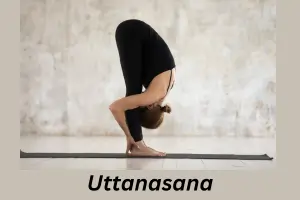Introduction
Uttanasana or Standing Forward Bend Pose yoga in Sanskrit, is a foundational yoga pose that involves a deep stretch of the hamstrings, back and spine.
The name “Uttanasana” comes from “Ut” meaning “intense” and “Tan” meaning “stretch.”

This pose helps in calming the mind while energizing the body, making it a staple in many yoga sequences.
Uttanasana not only improves flexibility but also aids in relieving stress and anxiety, making it beneficial for both physical and mental well-being.
Steps to Perform Uttanasana (Standing Forward Bend Pose yoga)
- Begin in Tadasana (Mountain Pose yoga): Stand tall with your feet hip-width apart, arms by your sides, and weight evenly distributed between both feet.
- Inhale deeply: As you inhale, raise your arms overhead and lengthen your spine.
- Exhale and hinge forward: On the exhale, hinge at your hips, keeping your back straight as you fold forward towards your feet. Allow your head and neck to relax.
- Touch the floor or hold your ankles: Depending on your flexibility, either place your hands on the ground beside your feet or hold onto your ankles. If you can’t reach the floor, let your hands rest on your shins or thighs.
- Engage your legs and core: Keep your legs engaged, with a slight bend in the knees to avoid overstraining your hamstrings. Activate your core to support your spine during the forward fold.
- Breathe deeply: Hold the pose for 20-30 seconds while breathing deeply. With each exhale, try to fold a little deeper, bringing your chest closer to your thighs.
- To release: Inhale and slowly rise back up to a standing position, keeping your spine straight as you come up.
Benefits of Uttanasana (Standing Forward Bend Pose yoga)
- Improves Flexibility: Uttanasana stretches the hamstrings, calves, and hips, helping to improve overall flexibility, especially in the lower body.
- Strengthens the Spine: The forward fold lengthens the spine, relieving tension in the back and promoting spinal health.
- Relieves Stress and Anxiety: This pose has a calming effect on the nervous system, helping to reduce stress and anxiety while encouraging mental clarity.
- Stimulates Digestion: The compression of the abdomen during the forward fold stimulates the digestive organs, helping in better digestion and relieving bloating.
- Enhances Blood Flow: As an inversion, Uttanasana increases blood flow to the brain, which can help improve focus and relieve fatigue.
- Eases Tension in the Neck and Shoulders: The pose helps release tension in the neck, shoulders, and upper back, especially for those who spend long hours sitting or working on a computer.
- Boosts Energy Levels: By improving circulation and stimulating the internal organs, Uttanasana can rejuvenate the body and mind, reducing fatigue and lethargy.
Precautions and Contraindications for Uttanasana (Standing Forward Bend Pose yoga)
- Back Injuries: People with lower back issues should avoid this pose or perform it with bent knees to avoid strain. If the discomfort persists, it’s advisable to skip the pose.
- Hamstring Injuries: If you have tight or injured hamstrings, bend your knees slightly during the pose to avoid overstraining them.
- High Blood Pressure: Those with high blood pressure should perform a modified version of the pose, such as placing their hands on a chair or block instead of reaching the floor.
- Glaucoma: Inverted poses, including Uttanasana, should be avoided by those with glaucoma as the increase in blood pressure to the head can exacerbate the condition.
- Pregnancy: Pregnant women should avoid deep forward bends or perform them with modifications such as a wider stance and more support to avoid compressing the abdomen.
- Vertigo or Dizziness: If you experience dizziness or vertigo, practice this pose with caution or with modifications like keeping your head elevated.
Conclusion
- Uttanasana (Standing Forward Bend pose yoga) is a simple yet powerful yoga pose that offers numerous physical and mental benefits.
- By deeply stretching the hamstrings and spine, this pose enhances flexibility, strengthens the back, and promotes relaxation.
- However, it’s essential to approach this pose mindfully, especially if you have existing conditions such as back or hamstring injuries.
- With regular practice, Standing Forward Bend can improve posture, reduce stress, and boost energy, making it a valuable addition to any yoga routine.
- Whether you’re a beginner or an experienced practitioner, this pose helps create a sense of balance and well-being in both body and mind.
